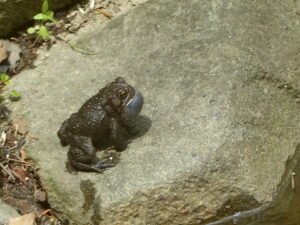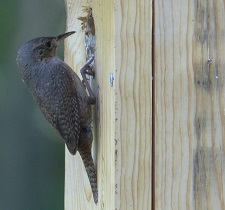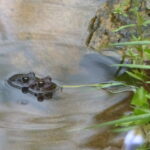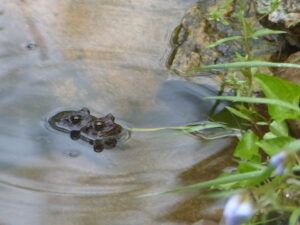by Winding Pathways | Sep 22, 2022 | (Sub)Urban Homesteading, Amphibians/Reptiles, Birds, Garden/Yard, Nature
We hadn’t seen either for a while but one September morning there they were. Mr. Toad and Ms. Wren.
Mr. Toad

Toads sing loudly day and night.
All summer Mr. Toad contentedly lived beneath a tomato plant snacking on an occasional juicy bug. Ms. Wren meanwhile forayed about the yard snatching bugs and feeding her brood. In September Mr. Toad’s favorite tomato plant died back, probably tired after producing plenty of tasty fruits and no longer able to give Mr. Toad a worthy hiding place. And, after the babies fledged, Ms. Wren worked the prairie grasses and woods.
On that September morning, Rich noticed sweet potato leaves trembling a bit. He brushed aside the foliage and there was Mr. Toad out seeking breakfast.
The fall equinox is almost here. With it comes the short days and cool temperatures that make garden plants shrink. Mr. Toad is cold-blooded. Summer’s moist heat is to his liking, but before the cold comes, he must retire for the winter. So, down he goes, digging into the soil to find a place to snooze through the winter, no doubt dreaming about next summer’s juicy bugs under a new tomato plant.
We bid Mr. Toad adieu for the winter and said, “Thanks for helping with our gardening. See you next spring.”
Ms. Wren

Checking the nest box.
Mr. Toad isn’t our only garden worker. Last winter we set up a wren house and by May Ms. Wren and her partner moved in. The couple raised two broods of ravenous babies in our garden. They enjoy the same fare as Mr. Toad but hunt more in our crop’s leaves instead of under them. The industrious parents spend nearly every daylight hour combing the garden and beyond for insects to feed their chicks.
Our last brood of garden wrens fledged in mid-August but stuck around a while. The family hunts insects in the woods behind the house but by the fall equinox they’ll get the urge to hop on a north wind some night and head south. When we’re shoveling snow, they’ll be snacking on bugs in a warm place.
Parting is Sweet Sorrow When Mr. Toad and Ms. Wren Bid Us Adieu
It’s hard to tell exactly when our wrens leave. Sometimes they linger into October but eventually one of us will say, “I haven’t seen or heard a wren for a while.” Yup, they’ve left for the season. We also bid them adieu and say, “Come back. See you next spring.” We miss Mr. Toad and Ms. Wren for the good work they do and for knowing we provide safe homes for them. We will put up wren boxes come March of next year and search for Mr. Toad sometime when the ground thaws.
About the Equinox
The Fall (autumnal) equinox is on or near September 21st. It’s one of two days when the sun crosses the celestial equator and every place on earth receives approximately 12 hours of daylight and 12 hours of darkness. The other is around March 21, the Vernal equinox. After the fall equinox the dark hours push daylight away until December 21 when days again begin to lengthen in the Northern Hemisphere. Plants and animals are super sensitive to day length and more aware of slight changes than most people.
by Winding Pathways | May 27, 2021 | Amphibians/Reptiles
Starting about mid-May when days and evenings began to warm up we’d hear off tune, extended croaking in damp spots around the yard, high in the trees, tucked into the woodpile and even on the side of the house. A few days later, high-pitched off-key trills burst from the little pond outside our bedroom window. It’s spring in Iowa and the tree frogs and toads are loving the moisture and warmth as they initiate their spring serenade.
Hyla Versicolor, or eastern Grey Treefrog, are fascinating amphibians. These diminutive creatures – about 2 and a half incles long – can change their rough, mottled skin within moments to better blend into their environment. Their large toe pads help them climb most surfaces, including buildings. Although they prefer woods’ edges, they also are found clinging to houses and even light posts! Once we spotted one clinging to our window. After mating, they tend to wander off into the forests to feed.
In winter they shelter under tree bark or leaves. A fabulous adaptation of changing glycerin to glucose that circulates through their organs prevents ice crystals from forming. Although remaining water freezes, they do not die. Come spring they thaw out to serenade us again.

Toads need water to mate.
The other night caller is the American Toad. Come dusk through the wee night hours, they sing merrily and mightily. They wander to the water to mate and reproduce, then they hop off to eat insects. They are especially helpful in gardens. Some of our friends even make toad habitats for them! Two protections protect these slow moving amphibians. A gland near their eyes secrets a nasty liquid that repels predators. This gland does NOT cause warts. That is just a silly story people tell kids for some reason. And they pee. When picking them up grasp them gently around the middle and hold them away from your body so you don’t get sprayed. Toadlets hatch by the hundreds a few weeks into summer and somehow make their way to safety. We hope you enjoy these late spring singers.
by Winding Pathways | May 28, 2020 | (Sub)Urban Homesteading, Amphibians/Reptiles, Garden/Yard
For many years Rich wrote a nature column for the Cedar Rapids GAZETTE about little known aspects of natural history common in suburbia. He was amazed when more people responded to a column on toads than anything else he had written. People like toads. Some readers called him to talk about “their” toad that lives in the garden or a damp corner in the garage. They wondered what treats they could give “their” toad.
Toads Range Far and Wide
Toads herald spring’s arrival with lusty evening trilling, usually in May. Common and intriguing, they enjoy living in suburban yards as well as woodlands and wetlands.
Many toad species inhabit the world but the Eastern Toad is most common in the United States. It ranges from about Nebraska east to the Atlantic and from southern states north to nearly Hudson’s Bay in Canada.
Where do Toads Live?
Both toads and frogs are amphibians. (The bloopers at the end of this video are fun to watch! Shows what it takes to put together even one short educational video!)
Toads, however, spend much of their lives away from water. A damp shady place to live and plenty of insects and other invertebrates to eat suits their needs. Toads often spend the day hiding in damp garages, under rotting logs, and in secluded garden spots. Come evening they hop around seeking tasty bug meals.
As amphibians toads need standing water to reproduce. Each spring toads hop to ponds, wet road ditches, and big puddles to serenade the night with their loud trilling. Females lay two strings of eggs in the water that hatch into tadpoles within two weeks. The warmer the weather the faster the eggs hatch. Toad tadpoles are easy to recognize. They are tiny, black, and have bodies much larger than their thin tail. Often hundreds swarm in a small pool. In less than two months they change into mini toads that hop far and wide seeking a place to live. They’ll eventually grow to about three inches long.
-

-
Toads sing loudly day and night.
-

-
Toads need water to mate.
Who Eats Toads?
Although many animals enjoy a frog meal, few eat toads. When bothered toads often emit a foul-tasting liquid that makes a hungry dog or raccoon immediately drop the animal unhurt. Probably their main predator is the hognose snake, which relishes a toad meal.
Caring for “Your” Toad
Most people like toads and many gardeners create damp quiet places in their gardens for them to take shelter during the day and forage for pesky insects come nightfall. As for a toad treat, well, they really don’t need one but they might like to snack on a few mealworms or earthworms.
#
by Winding Pathways | May 4, 2015 | (Sub)Urban Homesteading, Amphibians/Reptiles, Garden/Yard, Nature
The annual evening toad serenade has begun! From May into summer rural and urban folks can enjoy the loud trilling announcing toad lovemaking season. Nature’s summer music.
As amphibians, toads require standing water to reproduce but unlike many frogs they don’t need watery abundance. Toads lay their eggs in small pools that often dry up by summer. Eggs hatch quickly into tiny black tadpoles. While bullfrog tadpoles take two years to change into adult frogs, toad tadpoles are speedsters that transform into tiny hopping miniature adults by mid-summer. Often hundreds of these tiny creatures can be spotted seeking cool damp places to live.
Toads are voracious insect eaters, and gardeners delight in having them live under squash vines or tomato plants. Some people even construct tiny toad homes to encourage them to live in the garden.
We’re lucky to have a big toad living in a shed near our garden. His home is damp and cool with plenty of insects to keep him well fed.
According to the National Wildlife Federation, when pestered, toads eject a watery toxic substance from the parotoid glands. The toxin discourages dogs, raccoons or other hungry varmints intent on a meal from eating them. Few predators bother the placid toad. This bufotoxin can cause an allergic reaction in people. But humans do NOT get “warts” from toads.
Homeowners can encourage toads to take up residence. Building a small pond creates a toad magnet and maintaining a few damp places in the garden will provide toad homes. Avoid insecticides and, thus, encourage worms and insects for these intriguing animals to gorge on.
Kids love toads. When our children, Dan and Nancy, as small children delighted in watching them in our small backyard pond. Toads help transform a boring yard into a wondrous one!




